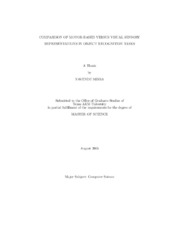| dc.description.abstract | Various works have demonstrated the usage of action as a critical component in allowing
autonomous agents to learn about objects in the environment. The importance
of memory becomes evident when these agents try to learn about complex objects.
This necessity primarily stems from the fact that simpler agents behave reactively to
stimuli in their attempt to learn about the nature of the object. However, complex
objects have the property of giving rise to temporally varying sensory data as the
agent interacts with the object. Therefore, reactive behavior becomes a hindrance in
learning these complex objects, thus, prompting the need for memory.
A straightforward approach to memory, visual memory, is where sensory data is
directly represented. Another mechanism is skill-based memory or habit formation.
In the latter mechanism the sequence of actions performed for a task is retained. The
main hypothesis of this thesis is that since action seems to play an important role in
simple perceptual understanding it may also serve as a good memory representation.
In order to test this hypothesis a series of comparative tests were carried out to
determine the merits of each of these representations. It turns out that skill memory
performs significantly better at recognition tasks than visual memory. Furthermore,
it was demonstrated in a related experiment that action forms a good intermediate
representation of the sensory data. This provides support to theories that propose
that various sensory modalities can ideally be represented in terms of action. This
thesis successfully extends action to the role of understanding of complex objects. | en |


